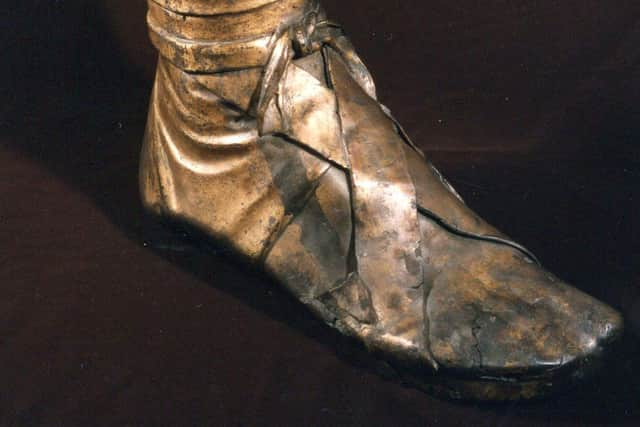The mystery of Scotland's 'legless' Roman - where did it come from?
Let us know what you think and join the conversation at the bottom of this article.
However, one priceless artefact in particular shows us our ancient invaders enjoyed a firm foothold in the land they dubbed Caledonia.
The item in question, a gilded bronze lower right leg, is believed to have belonged to an elaborately-detailed equestrian statue erected in the late second century AD.
Advertisement
Hide AdAdvertisement
Hide AdIt was unearthed by accident along with its stone base in 1820 from a bog in Milsington, near Hawick in the Borders, and the question is often asked, where did it come from, and where is the remainder of what must surely have been a grand monument?
The precise origins of the peculiar finding has left archaeologists and historians scratching their heads for more than a century.
Experts studying the rare artefact, which is part of the National Museum of Scotland’s collection, have established that the foot of the sculpture once had a spur attached, which is believed to have been lost before the item was rediscovered in the Duke of Buccleuch’s charter room at Dalkeith in 1920.
Further examination reveals that the statue was modelled from sheets of wax – seams are visible on the inside of the leg – before being cast in bronze.


Lead was added to the mix to make the metal flow more efficiently, and the finished item was then coated in gold – but not all over. The gilded regions are absent from the top of the leg where a cloak would have once concealed the imperfections.
Dr John Reid, Chairman of the Trimontium Trust, which cares for the Roman fort of Trimontium in Melrose, says the leg and the missing equestrian statue it was once connected to, were almost certainly cast elsewhere and brought northwards.
He said: "We know it’s from an equestrian statue because there’s a little fixing for where a spur would’ve gone on the heel, which was characteristic for equestrian statues. It’s also a dead ringer for the equestrian statue of Marcus Aurelius in Rome.
“Another thing we know is that it’s not a local copy. It’s the real deal made by expert bronze workers, probably somewhere in the heart of the empire, or certainly in a top class foundry in southern Roman Britain and not put together on the frontier.”
Advertisement
Hide AdAdvertisement
Hide AdDr Reid says he believes the leg must have been looted by raiders, possibly during an uprising in the latter days of the Roman occupation.
He said: “I think this has been deliberately buried and, if you look closely, you will see the leg has been very crudely lopped off rather than surgically dismembered.”
Reflecting on the historical value of the gilded leg, Dr Reid says it is a unique artefact that can tell us much about the struggles in Scotland in the early part of the first millennium.
He added: "In archaeological terms, this artefact is invaluable; there’s nothing else like it in Scotland.
"We’ve all seen scenes of Saddam Hussein’s statue being toppled, I suspect there has been a very similar situation
“It tells you something about the violent nature of what may have been going on at the time, because it’s not normal to be hacking off huge chunks of statues.”
A message from the Editor:
Thank you for reading this article. We're more reliant on your support than ever as the shift in consumer habits brought about by coronavirus impacts our advertisers.
If you haven't already, please consider supporting our trusted, fact-checked journalism by taking out a digital subscription at https://www.scotsman.com/subscriptions.
Comments
Want to join the conversation? Please or to comment on this article.